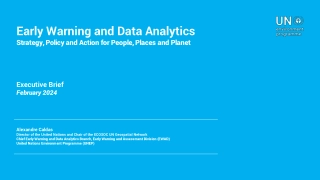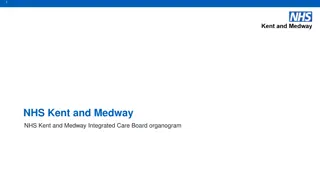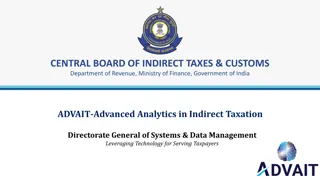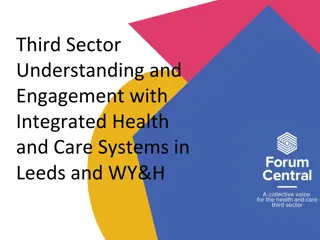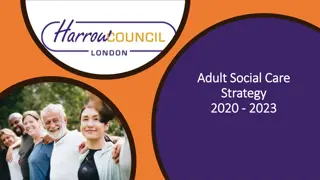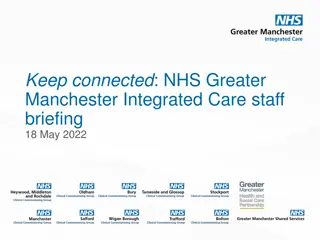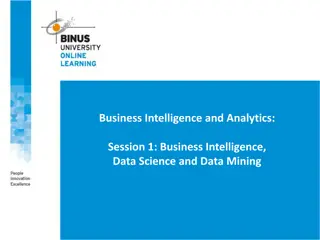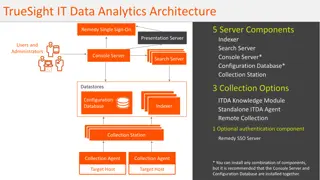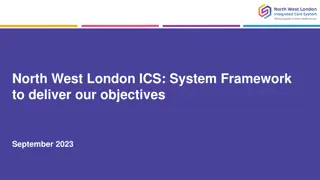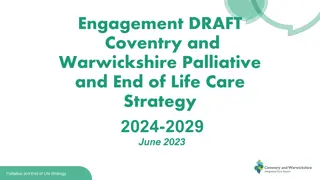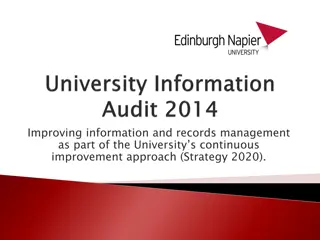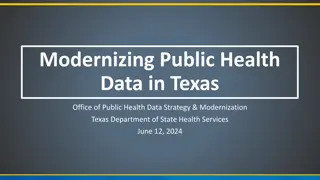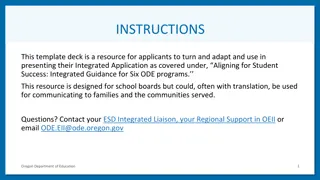Nottingham and Nottinghamshire Integrated Care System Data, Analytics, Information, and Technology (DAIT) Strategy 2020-2024
Nottingham and Nottinghamshire Integrated Care System has developed a strategic plan to address the challenges in the local health and care system. The plan focuses on improving the quality and sustainability of services by emphasizing digital transformation, data analytics, and technology integration. By aligning key priorities and investing in long-term transformation, the aim is to enhance patient care, workforce capabilities, and overall service efficiency.
Download Presentation

Please find below an Image/Link to download the presentation.
The content on the website is provided AS IS for your information and personal use only. It may not be sold, licensed, or shared on other websites without obtaining consent from the author. Download presentation by click this link. If you encounter any issues during the download, it is possible that the publisher has removed the file from their server.
E N D
Presentation Transcript
Nottingham and Nottinghamshire Integrated Care System Data, Analytics, Information and Technology (DAIT) Strategy 2020-2024 13 August 2020 v3.1 Please cite this work has been informed by the Nottingham and Nottinghamshire ICS when referencing. This information has been placed in the public domain in order to benefit patients across the country as we believe the experience and approach may be useful for others, however we request that acknowledgement to the work in Nottinghamshire is made and referenced in all materials. This helps us to understand the wider impact benefits of our programme. 1
Foreword Across Nottingham and Nottinghamshire there are more people living longer in ill health, unprecedented levels of demand for care and support, workforce shortages and considerable funding constraints. Combined these factors continue to place an ever- increasing strain on the local health and care system and looking to continue to do more and more of the same each year is not sustainable. In response to this the leaders of our local health and care system have come together to develop a five-year strategic plan, underpinned by the ICS Clinical and Community Services Strategy, that sets out a shared vision to both increase the duration of people s lives and to improve those additional years, allowing people to live longer, happier, healthier and more independently into their old age . Delivery of this vision will be characterised by moving from a health and care system that is often siloed and reactive in nature to one where all partners are focused on the entire spectrum of interventions from prevention and promotion to health protection, diagnosis, treatment and care and integrates and balances action between them. Dr Andy Haynes ICS Executive Lead However, we recognise that without the right digital systems, or data, analytics, information and technology, this transformation risks being limited both in scale and the overall impact it has on our population. We recognise there is a critical relationship between high levels of digital maturity and service transformation and that we need to plan and deliver both in tandem in order to deliver our long term vision. In doing so we aim to: Define key areas of digital priorities that we need to invest in to support long-term transformation and deliver the LTP and our five-year strategic plan Provide a structured approach to digital strategy development that helps the ICS find the right balance of investment across these priorities and other local needs SRO Data, Analytics, Information and Technology Successful Digital Transformation: Everyone is treated as an individual, given the tools to stay healthy and supported in their own homes, and to drive their own care when they need it Every health and care professional is able to operate at the top of their capability, with the time they need to care for people The system can optimise the care it provides through data, analytics and research, and services can be planned and commissioned more efficiently This strategy is designed to help establish a shared commitment and vision for digitally-enabled transformation across the health & care system. The strategy builds on the significant increase in pace of digital transformation in response to COVID-19, and it supports the ICS Clinical and Community Services Strategy and the five year strategic plan. As recovery plans become clearer and have an impact on existing organisations strategies, the strategy will iterate to reflect those changes. 2
The context for this strategy Overview Challenges to be addressed Our health and care partners across Nottingham and Nottinghamshire came together in 2016 in a Sustainability and Transformation Partnership (STP) with the collective goal of improving the quality and sustainability of health and care services. The key challenges faced and therefore to be addressed by the Nottingham and Nottinghamshire Integrated Care System can be grouped into three categories, that have a reinforcing effect on each other: the health and wellbeing of the population, the provision of services and the effective utilisation of health and care system resources. This collaboration subsequently evolved into an Integrated Care System (ICS) in 2018 focussed on becoming a fully population health focused health and care system a system where all partners are focused on the entire spectrum of interventions, from prevention and promotion to health protection, diagnosis, treatment and care; and integrates and balances action between them. More people are living longer in ill health Deprived communities have greatest exposure to factors that impact adversely on health COVID has potentially widened the health inequalities gap Health and Wellbeing Current health & care services have been set up to help sick people get well, often in a hospital setting Do not routinely and systematically identify and support people with ongoing needs Do not use digital services well in health and care ICS members include: Nottingham City Council Nottinghamshire County Council City Care Nottingham and Nottinghamshire CCG Nottingham University Hospitals NHS Trust Sherwood Forest NHS Foundation Trust Nottingham Healthcare NHS Foundation Trust Service Provision Increasing vacancies in health and care workforce Ageing estate with high level of backlog maintenance Significant financial deficit forecast over next 5yrs, underpinned by recurrent deficit, non-delivery of savings plans and increasing activity/demand Resource Utilisation This document describes the over-arching data, analytics, information and technology (DAIT) strategy to support the Nottingham and Nottinghamshire ICS address these challenges The ICS covers a diverse population of over 1 million people living in the City of Nottingham (332,000) and Nottinghamshire County (764,700), however this does not include the residents of Bassetlaw as they are part of the South Yorkshire and Bassetlaw health care system 3
If we get this right how will it feel for people As a citizen living in Nottingham and Nottinghamshire this means: As a person receiving support from our health and care system: As aperson working in our health and care system: We will support our population by providing them with the skills, training and tools to access digital health and care services in order to empower and enable them to manage their health and care and reduce health inequalities and social isolation. You will be able to communicate with health and care professionals through a single secure application, the NHS App. You will be provided with a range of information and online services to support the delivery of your health and care services. We will provide support and training to our health and care professionals to develop the skills that they need to use digital technology in order to enable them to undertake their job to the best of their ability. All health and care professionals will have the right tools to do their job and will be supported by digital infrastructure to deliver services in any of our buildings, community and people s homes. We will not worsen digital inequalities; we will work to reduce them We will improve how we proactively identify the health and care needs of our population in order to identify and put in place support and treatment that our population need in order to stay well. We will provide our population with public facing digital health and care service to enable them to access health and care services digitally from a single trusted place and provide them with the information they need about their health and care and community services. We will provide the people involved in providing health and care with the information they need in one place to enable them to provide the most appropriate health and care to our population. Your data is captured by electronic health and care systems which will be interoperable to make clinical information visible to professionals and service users where required. Information will be held and moved safely with regular testing to ensure that the systems are secure. We will reduce the number of times people have to repeat themselves to health and care services - by making the right information available at the right time. Our vision for DAIT is therefore for our citizens and service users to engage with us digitally and for our front line professionals to be supported by digital systems to make their work easier by giving them access to everything they need 4
Where we are starting from (the digital / DAIT context) Digital Transformation Digital Evolution Digital Revolution Accessibility and availability of digital health and care sporadic and silo d Overall utilisation of population facing digital services low Value of digital health and care recognised and underpinned by national policy Need to increase investment in digital technology through transformation, current baseline spend c. 1-1.5% The Covid-19 period of February to May 2020 saw a shift change in the use and adoption of digital technology across Health and Care, with an additional 2.5 million invested in digital services This change has seen the adoption of new models of care to manage people digitally Expansion of online and remote consultations and monitoring of people Empower and enable people to manage their health and care in order to self manage, self monitor and self serve Use of intelligence, analytics and behaviour insights target service and resources 178% increase in NHS App login from February 2020 to May 2020 ** Of Nottinghamshire would like access to digital service to manage their health * people in Nottingham or Of Nottinghamshire hadused digital to monitor their health conditions * people in Nottingham or 73% 30% Of Nottinghamshire would like to access health and care appointments via video consultation * people in Nottingham or Of people in Nottingham or Nottinghamshire hadaccessed appointments consultation * 10% 59% via video NHS App 193% increase in NHS App registrations during Covid-19 ** In order to revolutionise digital across the system we need to increase and enable; Of people in Nottingham or Nottinghamshire hadaccessed directories of services online * 45% Feb 2020 May 2020 The accessibility and availability of digital technologies to our people to enable online and remote consultations and information The utilisation of data, analytics, intelligence and behavioural insights to improve health inequalities and provide personalised care Digital first models of care, including full electronic records in hospitals and elsewhere A single digital health and care record Empowered and skilled workforce Investment in digital technology to deliver service transformation and maximise benefits for the people of Nottinghamshire In Nottinghamshire historically 30% of people used digital health and care services* Nottingham and In Nottinghamshire increases to 73% for people expectations in future * Nottingham and this 14.2K 41.3k 259% increase in online prescriptions ordered May 2020 during Covid-19 ** Feb 2020 1,661 Online Prescriptions Ordered 5,956 Online Prescriptions Ordered 30% 73% ** Information Source NHS App [June 2020] Connected Nottinghamshire public engagement and research [2018]. Insights gathered pre Covid-19 with Board commitment to re-evaluation of position post Covid-19 5
What is the basis of our DAIT strategy? What do we mean by DAIT Our DAIT strategic initiatives We have developed our definition of Data, Analytics, Information and Technology (DAIT) from Gartner the well-respected global digital research company - in the picture below. It encompasses the business context, the technology, the data management, the information creation and the analytics to deliver the best customer experience to the people we serve. In line with our definition of DAIT, the challenges we face and the known expectations on our health and care systems partners we have defined five strategic initiatives to drive forward our strategy. DAIT Strategic initiative 1. Develop our Public Facing Digital Services 2. Develop our Population Health Management capability, aligned with powerful Analytics and Intelligence to support all initiatives 3. Complete the digitisation of providers by 2024 4. Develop a single summary health and care record and supported workflows, by interoperability of our health and care data and systems 5. Improve the digital literacy of the workforce and the capability and capacity of our digital and informatics specialists and develop our culture, investment and governance 6
DAIT objectives and how they support the system Strategic initiative Strategic objectives System Challenges HWB SP RU Digital contact becomes the default route for public to engage with services Create Digital Health and Care People Senate Develop our public facing digital services Ensure PHM approach is supported with appropriate resources including better analytics, tools and techniques , which will support all initiatives Establish a Health and Care Analytics Collaborative Build on our Track & Trace capability Embed a systematic approach to developing & monitoring system outcomes and proactively finding and enabling new interventions Augment artificial intelligence and human skills in designing care services Develop our Population Health Management (PHM) capability, aligned with powerful Analytics and Intelligence to support all our initiatives Support the delivery of the ICS Clinical Services and Community Services Strategy through the continued implementation of technology enabled care Implement full EPRs in Acute care and implement the GP IT Futures Programme Enable all staff to work in any location as appropriate Rationalise and modernise diagnostic services and reporting Enable the visibility of capacity across all care settings and the ability to schedule the move of patients quickly Roll-out of electronic prescribing and drug administration Complete the digitisation of providers by 2024 Single health and care record available to all staff Agree and embed system wide standards for data capture and exchange Ensure consistent capture and availability of patient s wishes Develop a single summary health and care record and supported workflows, by interoperability of our health and care data and systems Create a mechanism for sustained investment (aligned with five year strategic plan) Increase the digitally literacy of our workforce, including the skills of managers in interpreting new methods of presenting complex information Develop a workforce plan for digital specialists Develop governance arrangements to include a Digital Design Authority Improve the digital literacy of the workforce, and the capability and capacity of our digital and informatics specialists and develop our culture, investment and governance 7
2020 2021/23 2023/25 Stabilise Population Health Management processes Digital contact becomes the default route for the public to engage Personalised Health & Care Services designed for our population Delivering outstanding Digital Health & Care Nottingham & Nottinghamshire Digital Health & Care Roadmap Agreed approach to developing outcome measures Create an augmented intelligence solution for care design Health & Care service provision fully exploits digital services eg EPR Build on Track & Trace technologies for future health & care benefit Integrated health & care Digital records & technologies deployed Affordable and sustainable digital care delivered across the ICS Ongoing digital transformation projects by the Notts Digital Collaborative Integrated health & care analytics technologies deployed Build common service platforms to exploit integration Increase investment in Digital as per 5yr Plan with 3x Return Establish the Notts Health & Care Analytics Collaborative Create the Digital Health & Care People Senate Create a Digital Design Authority mechanism Establish sustainable Digital investment at system level Create a workforce plan for Digital specialists 8
Ensuring Delivery of our Strategy (1) 1. Clear Expectations A Digital Health & Care People Senate will ensure everyone involved in the ICS; including the general population, people using services, people providing health and care services or people delivering technologies; will be able to shape those services and have a personal investment in their success. All ICS organisations will have an Executive Level champion committed to the collaborative DAIT Agenda as Senior Responsible Owner for their organisation with authority to make decisions. All strategies for health and care delivery across Nottingham & Nottinghamshire will include a Digital First perspective. 1. Clear Expectations 2. Sustainable Delivery Careful investment in modern & secure technology improves care, increases productivity, reduces the burden on our workforce freeing up more time to care, helps manage demand by enabling care to take place in the right setting and improves patient experience. DAIT is a key enabler of the five-year strategic plan and the system operational plan. Resources will be reviewed (capital & revenue) to ensure appropriate levels of investment in technology are made in health and care services by 2024. We will robustly evaluate what we have done and what we said we would do, and publish it. The system will continue to work together to bid for NHS Targeted Transformational Funding. Recognising the financial challenges, a robust approach to benefits realisation will be used. The target return on investment will be at least 3x cost, with a proportion re-invested for further benefits. Active ICS & Board support Invested people 2. Sustainable Delivery Long-term resource Investments Strong benefits management 3. Good Governance Clear Commitment to collaboration programme delivery 9
Ensuring Delivery of our Strategy (2) 3. Good Governance The System-wide Stakeholder Board (DAIT) will have three key roles for the health and care system: System Partnership & Decision Making Strategic Direction Oversight and Assurance : Programme Implementation System level digital transformation projects will be delivered through the Digital Health & Care Collaborative, for example PFDS & digital inclusion, capacity & flow and health & care community portal. A collaborative approach for system data, analytics & information will also be set up, building on the learning from the Nottinghamshire Health & Care Data Cell established as part of the COVID-19 response The DAIT strategy and work programme will be delivered through professionally managed programmes of work to ensure progress towards our goals The top 3 barriers to implementation are Commitment, Money and Culture. We will address these barriers by having: A robust business case process to underpin any investment A risk management process that ensures that risks, issues, actions and decisions are managed by the Stakeholder Board Escalation mechanisms will be in place through the System-wide Stakeholder Board; and ultimately the ICS Board for resolution ICS Board System wide Stakeholder Board for DAIT DIGITAL TRANSFORMATION PROGRAMME (Health & Care Digital Collaborative) SYSTEM DATA, ANALYTICS & INFORMATION (Health & Care) ICS members collaborate to deliver strategy Working closely with stakeholders is key to successful delivery District & Borough Councils NEMS Care Homes Third Sector 10
Glossary Acronym / abbreviation Apps Artificial Intelligence (AI) Explanation Short for application . Refers to a programme or piece of software, in particular on a mobile device Technology operating in a way that would require intelligence if performed by humans Devices & technologies which help people to stay safe in their own home & increase their ability to self-manage. Includes capabilities such as telehealth, telecare, telemedicine, smart home technology, motion detectors, wearable devices & in the future more advanced digital technology such as robots & the internet of things (see below) Assistive Technology Cloud-first Considering in the first instance and primarily using systems and storage that are hosted and accessed remotely Computer-based products, solutions, systems and approaches; Digital Transformation is the use of frequently changing digital technology to solve problems, transforming processes that were non-digital or manual to digital processes. Locally, the term Digital is interchangeable with DAIT Patient health and care information recorded and available digitally Digital / Digital Transformation Electronic Patient Records (EPR) Fast Healthcare Interoperability Resource (FHIR) The industry standard for exchanging information between healthcare systems Health is a state of complete physical, mental and social well-being and not merely the absence of disease or infirmity (WHO s definition); one of the 3 challenges to be addressed by the ICS and the thread coloured green in this strategy A partnership that brings together health and social care services to meet the needs of the local population A partnership across Nottinghamshire, consisting of three ICPs, setting the goals and strategy for health and care IoT describes a scenario where digitally enabled resources or assets (e.g. devices, cars or buildings) are connected to a network that enables them to link, interact and exchange data Systems and software that can communicate, share data and work efficiently with one another. These enable an individual s health and care information to be shared as they move across the NHS and social care. In our region this is known as East Midlands One-Care The process by which systems automatically learn from data / experience without human intervention Primarily using and considering mobile devices for capturing, using and interacting with information A mobile application through which citizens can access a range of NHS services Health and Well Being (HWB) Integrated Care Partnership (ICP) Integrated Care System (ICS) Internet of Things (IoT) Interoperable Longitudinal Health Care Record (LHCR) Machine learning Mobile-first NHS App A platform is a mixture of hardware, software and digital services on which to base applications, processes or technologies. Each platform has its own set of rules that dictate how they should work. They can support one organisation or many organisations; in our usage here they support many organisations, forming part of a business ecosystem which shares data securely with other organisations using agreed rules, standards and protocols. Alibaba and Amazon are examples of platforms that support an ecosystem linking millions of individuals and organisations. Platform Population Health Management Using information and insight to understand the needs of populations and target resources and interventions accordingly How we deploy our workforce, finance and estates in delivering services, one of the 3 challenges to be addressed by the ICS, and the thread coloured purple in this strategy Resource Utilisation (RU) Service Provision (SP) Provision of health and care services, one of the 3 challenges to be addressed by the ICS and the thread coloured blue running through this strategy 11















